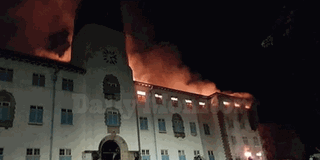Prime
Inside Makerere University fire report

Makerere University Main Building after catching fire on September 20, 2020. PHOTO/STEPHEN OTAGE
What you need to know:
- The report says the wrong system in the Main Building could have been the source of fire.
An investigation into the fire that gutted the Main Building at Makerere University last year has established there were no functional cameras at the country’s oldest premier education institution, making it difficult to ascertain the cause of the inferno.
However, investigators in the report titled ‘Investigation into the Cause of Fire at Makerere University Main Building’ were of the opinion that because the building’s electrical wiring was more than 30 years old, there is a possibility that this could have been the source of fire.
The findings contained in the National Building Review Board November 2020 report established that the fire started at around 11.30pm on September 19, 2020, in the bursar’s office or Room 315 on the first floor of the Main Building but ruled out arson by conventional fuel accelerants such as diesel or kerosene.
The 11-member team comprised staff from the National Building Review Board, the Criminal Investigations Department (CID), the Directorate of Forensic services, the Directorate of Government Analytical Laboratory and the Occupational Safety and Health department of the Ministry of Gender, Labour and Social Development.
Ms Rachel Namuli, who led the probe, declined to comment on the findings, saying she was in a meeting. She did not respond to this newspaper’s subsequent calls.
Asked about the non-functionality of the cameras, the university vice chancellor, Prof Barnabas Nawangwe, yesterday said: “The report was issued a long time ago. That is what they thought. It is public information. Quote the report. Why don’t you go inspect whether there are cameras there? Those are estates matters.”
The report notes that there were continuous electrical repairs on the building by people who lacked qualifications and never followed the building’s designs.
“Arson by lighting a match or leaving a smouldering item burning could not be established or ruled out, because there were no CCTV cameras in the building and the guard on duty was asleep in the locked building. In addition, there were ongoing labour disputes in the university,” the report notes.
Observations
It adds: “It is the investigation team’s professional opinion that it was an electrical fire. This is because electrical wiring was more than 30 years old and was due for replacement. There was continuous haphazard modification of electrical installations without due attention to original designs….”
Although the report says the Uganda National Bureau of Standards didn’t have the capacity to carry out the tests except for determining the cross-sectional area of the conductors, the type of cable, insulation and conductor materials, the forensic analysis looked at ash, burnt electrical cabling, fluorescent tube holder, burnt electrical kettle, extension cable and computer remains.
It was, however, suggested that further investigation be carried out on the origin of the fire using a pyrosium and petra sim software to reconstruct the spread of the fire from materials in the building and the composition of the building. The board is yet to purchase the software.
CID interviewed eight university workers who had accessed the building on the fateful day.
However, the report didn’t find any traces to link them to the fire since the last person left about 6pm, hours before the fire was noticed in the building. It established that the last person to enter the building was the security officer who was locked up in the building at the time fire was detected.
The CCTV camera at the printery showed that fire started at 11.30PM on Saturday, September 19, 2020, while the one at St Francis Chapel showed smoke coming out of the building at 12.41am (midnight) on Sunday, September 20, 2020.
“The possibility of the fire being started by someone in the building who found an alternative exit from the building cannot be entirely ruled out, since CCTV cameras in the Main Building were non-functional,” the report observed.
Probe team
The investigating team included Rachel Namuli (lead investigator – NBRB), Hans Mwesigwa, civil engineer – NBRB), Edward Kasule (electrical engineer – NBRB), Mr Jerome Olowo (architect – NBRB) and Eva Katushabe (civil engineer – Ministry of Gender). Others were Bernard Muhumuza (CID Commander KMP), Mary Mbabazi (head forensics KMP), (Rashida Nyanzi, head Forensics KMP North), Zerida Achola (CID). Stephen .S. Kibuuka (senior analyst – Government Analytical Lab) and Gloria Among (CID officer Wandegeya) completed the team.




